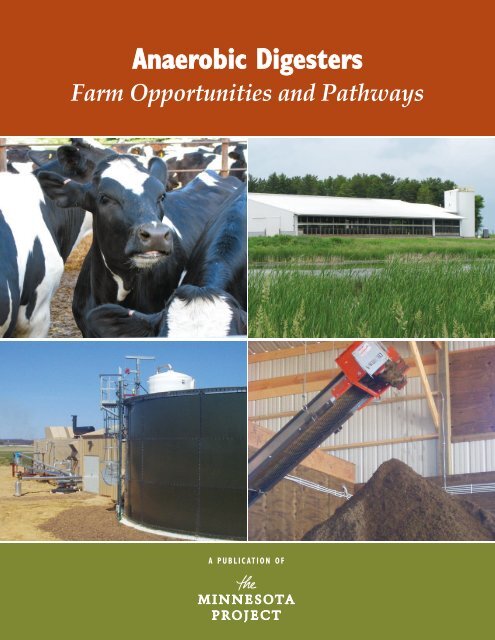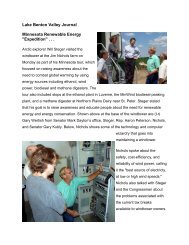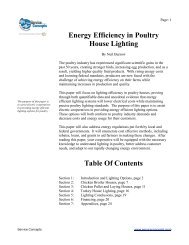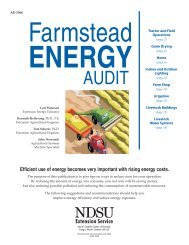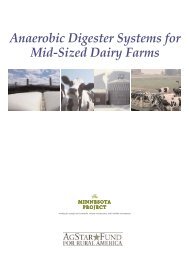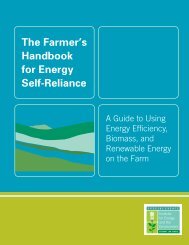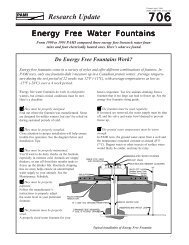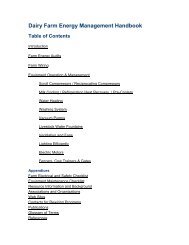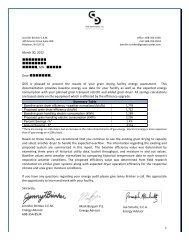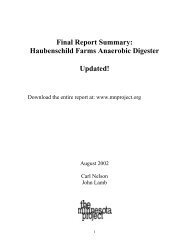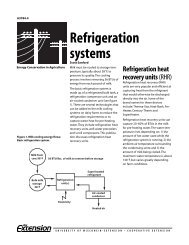Anaerobic Digesters - The Minnesota Project
Anaerobic Digesters - The Minnesota Project
Anaerobic Digesters - The Minnesota Project
Create successful ePaper yourself
Turn your PDF publications into a flip-book with our unique Google optimized e-Paper software.
<strong>Anaerobic</strong> <strong>Digesters</strong><br />
Farm Opportunities and Pathways<br />
A PUBLICATION OF
For More Information<br />
<strong>The</strong> <strong>Minnesota</strong> <strong>Project</strong><br />
651.789.3330<br />
www.mnproject.org<br />
ABOUT THE MINNESOTA PROJECT <strong>The</strong> <strong>Minnesota</strong> <strong>Project</strong><br />
is a nonprofit organization championing the sustainable<br />
production and equitable distribution of energy and food in<br />
communities across <strong>Minnesota</strong>. <strong>The</strong> organization focuses on three<br />
areas: the development and efficient use of clean renewable energy,<br />
promotion of sustainable agriculture practices and production, and<br />
consumption of local, sustainably grown food.<br />
Founded over 30 years ago, today's team works toward establishing<br />
a sustainable <strong>Minnesota</strong> by 2039 through policy research, education<br />
and outreach, as well as developing key ground-up, grassroots<br />
initiatives targeted at empowering communities and their leaders.<br />
ACKNOWLEDGEMENTS This publication was created using<br />
funding from the Office of Energy Security. Thanks to Janet Streff,<br />
Jeff Haase, and Laura Silver for their support for this project.<br />
Additional thanks to all staff at the <strong>Minnesota</strong> <strong>Project</strong> for their hard<br />
work and dedication.<br />
Finally, thanks to Doug Fischer for his review and comments<br />
regarding this document, his help was much appreciated.<br />
Photos All photos in this report, unless otherwise noted, have been<br />
provided by <strong>The</strong> <strong>Minnesota</strong> <strong>Project</strong> and its partners. <strong>The</strong> <strong>Minnesota</strong><br />
<strong>Project</strong> thanks <strong>The</strong> Midwest Ag Energy Network for use of its<br />
photos contained herein. In the event an image herein has been<br />
mistakenly misattributed, the image is the rightful property of its<br />
respective owner.<br />
© 2010 <strong>The</strong> <strong>Minnesota</strong> <strong>Project</strong>
CONTENTS<br />
INTRODUCTION 1<br />
ANAEROBIC DIGESTERS<br />
Chapter 1: Overview of <strong>Anaerobic</strong> <strong>Digesters</strong> 2<br />
Chapter 2: Uses and Benefits of <strong>Anaerobic</strong> Digestion 5<br />
Chapter 3: New Developments/Potential Revenue Streams 10<br />
Chapter 4: Evaluating On Farm <strong>Anaerobic</strong> Digester Feasibility 13
INTRODUCTION<br />
<strong>Anaerobic</strong> Digestion: A Brief Rundown<br />
<strong>Anaerobic</strong> digestion is a biological process in which microorganisms break<br />
down or, digest, organic material into its various primary components. <strong>The</strong><br />
organic material to be digested can be anything, really; from food waste, to<br />
grass clippings, to animal manure. As the organic material is broken down, it<br />
releases biogas. Biogas consists of 60-70% methane, 30-40% carbon dioxide, trace amounts of<br />
other gases like hydrogen sulfide and ammonia, along with a very small percentage of water<br />
vapor. When captured, biogas is most often used as fuel to power an engine that turns a<br />
generator, creating electricity. However, as methane is the primary constituent of natural gas,<br />
the biogas can also be burned as a heating or cooking fuel, used in refrigeration, or even<br />
potentially scrubbed of its impurities and sold as renewable natural gas.<br />
Biogas recovery systems are the technologies that make the above described process work.<br />
Biogas recovery systems couple anaerobic digestion technologies with biogas capture<br />
technology to produce, and then utilize, biogas in one contained system. Though a bit of a<br />
misnomer, biogas recovery systems are also commonly referred to as simply, ‘anaerobic<br />
digesters,’ the phrase which will be utilized in this document.<br />
So what do these fairly complicated preceding paragraphs have to do with farmers? <strong>The</strong><br />
Environmental Protection Agency estimates that over 8,000 dairy or swine farms across the<br />
United States have the potential to economically sustain an on farm anaerobic digester. In the<br />
proper conditions, anaerobic digesters could dramatically decrease farmers’ energy, bedding,<br />
and waste management costs, produce additional revenue streams, and make farm operations<br />
more environmentally friendly.<br />
This publication provides the most relevant information to farmers interested in learning about<br />
the benefits, challenges, and opportunities for pursuing an anaerobic digester on their farm. <strong>The</strong><br />
document discusses the myriad benefits associated with anaerobic digesters, the development<br />
of the technology around the world, and early steps farmers must take if they’re interested in<br />
pursuing such a project. In an effort to provide the most information in the smallest package,<br />
this document does not attempt to be exhaustive in all its descriptions and categorizations.<br />
Instead, the document provides references to documents providing greater depth of information,<br />
for readers interesting in delving deeper into a particular subject.<br />
This publication provides<br />
the most relevant<br />
information to farmers<br />
interested in learning about<br />
the benefits, challenges, and<br />
opportunities for pursuing<br />
an anaerobic digester on<br />
their farm.<br />
ANAEROBIC DIGESTERS: Farm Opportunities and Pathways 1
ANAEROBIC DIGESTERS<br />
Chapter 1: Overview of <strong>Anaerobic</strong> <strong>Digesters</strong><br />
Digester History/Implementation<br />
<strong>Anaerobic</strong> digesters have been used around the world for decades. Some of the earliest users of<br />
anaerobic digesters have been tracked all the way to mid-1800s India. 1 Additionally, some<br />
experts estimate there are literally millions of small scale digesters operating in places like<br />
China and India. 2 Of course, the digesters found in these areas were often very small and used<br />
primarily to capture gas used to heat homes and fuel kitchen stoves. Similar digesters can still<br />
be found today across rural China and more locally in rural areas of Costa Rica and Latin<br />
America. <strong>The</strong> successful implementation of digesters in areas like these, often with most limited<br />
resources, displays the basic workability of re-using organic waste to increase self sufficiency.<br />
Today, Germany is often looked at as the leader in modern, large-scale anaerobic digester<br />
implementation, with over 3,700 digesters in operation. 3 Comparatively, as of May 2010, the<br />
Environmental Protection Agency estimated there were only 151 on-farm anaerobic digesters<br />
operating in the United States. 4 Wisconsin led all states in digester implementation with 25<br />
anaerobic digesters producing over 95,638 MWh of electricity per year. <strong>Minnesota</strong> has 5 anaerobic<br />
digesters producing 4,084 MWh of electricity per year. To give the current state of the United<br />
States’ digester implementation some perspective, energy produced from all biogas uses<br />
currently accounts for less than one-half of one percent of the United States’ energy consumption. 5<br />
So, while early efforts in anaerobic digester implementation are encouraging, a great deal of<br />
expansion potential remains.<br />
<strong>Anaerobic</strong> Digester Designs<br />
As interest in anaerobic digesters has risen with the gradual change in our energy economy,<br />
various types of digester designs and technologies have developed. While there are many<br />
different organizations promoting specific types of anaerobic digestion systems, the various<br />
designs all generally break down into three or four basic digester types, with variations on a<br />
theme providing the diverse array of designs.<br />
<strong>The</strong> primary digester design categories are: Plug Flow, Complete Mix, Covered Lagoon, and<br />
Fixed Film digesters. <strong>The</strong> latter two of these designs are less suited to <strong>Minnesota</strong>’s climate type,<br />
but have seen some (though lesser) implementation in the region. In any event, as of May 2010,<br />
over 70% of operational on farm digesters were plug flow or complete mix systems operating at<br />
mesophilic temperatures (95–105° F). 6 While it is helpful to provide a general overview of each<br />
technology here, farmers will be best suited in learning the details of particular digester systems<br />
by talking to the experts and organizations capable of designing a system best suited to the<br />
specific needs of individual farm operations. 7<br />
1 Small Scale Digester Options., presentation by Andy Moss, BioCycle Conference. (2010).<br />
2 Biogas Production and Utilisation., Arthur Wellinger, IEA Bioenergy. (2006).<br />
3 <strong>Anaerobic</strong> Digester Technology, William F. Lazarus, University of <strong>Minnesota</strong>. (2009).<br />
4 <strong>Anaerobic</strong> <strong>Digesters</strong> Continue to Grow in the U.S. Market., AgStar. (May 2010).<br />
5 Biogas: Rethinking the Midwest’s Potential., Peter Taglia, Clean Wisconsin. (June 2010).<br />
6 <strong>Anaerobic</strong> <strong>Digesters</strong> Continue to Grow in the U.S. Market., AgStar. (May 2010).<br />
7 http://www.epa.gov/agstar/tools/directory.html.<br />
2 ANAEROBIC DIGESTERS: Farm Opportunities and Pathways
Breakdown of Digester Types Throughout the U.S. 8<br />
Farm Type Total Digester Plug Flow Complete Mix Covered Lagoon Other Digester<br />
<strong>Project</strong>s <strong>Digesters</strong> <strong>Digesters</strong> <strong>Digesters</strong> Types<br />
Dairy 126 74 27 16 9<br />
Swine 24 2 5 15 2<br />
Poultry 5 1 4 0 0<br />
Beef 2 2 0 0 0<br />
Plug Flow <strong>Digesters</strong><br />
Using a plug flow digester, animal waste is introduced into one end of a long,<br />
tubular digester and moves toward the other end. As the waste is digested<br />
and flows out the tail end, more waste is introduced on the front end. Plug<br />
flow digesters have mainly been used on dairy farms, due to their ability to<br />
handle slightly higher solids contents. Plug flow digesters are workable with<br />
manure containing 11 to 13 percent solids, and are well suited for operations<br />
that mechanically scrape out manure from barns. As evidenced in the table<br />
above, the plug flow design is, of yet, the most popular anaerobic digester<br />
design.<br />
Complete Mix <strong>Digesters</strong><br />
Mixed digesters combine all animal waste into one central tank and use agitation systems to<br />
mix the waste while it is digested. Sometimes, these tanks are partially buried, to take<br />
advantage of the regulated temperature below ground. Complete Mix digesters generally<br />
handle manure with 3-10% solids, and while they can be a bit more expensive than plug flow<br />
digesters, they take up a smaller footprint and are well suited for farm operations that wash out<br />
their manure.<br />
Another Digester Option<br />
Another type of digester design, an Induced Blanket Reactor (IBR), is being used right here in<br />
<strong>Minnesota</strong>. At the Jer-Lindy Dairy, near Brooten, MN an IBR digester was installed due to its<br />
quick digestion process (about 5 days), its small system footprint, and modular design. <strong>The</strong> IBR<br />
system propels incoming animal waste upward through a vertical column of bacteria rich<br />
liquid sludge. <strong>The</strong> constant exposure to the digesting bacteria helps speed up the digestion<br />
process and ensures thorough digestion of the incoming waste.<br />
8 Recreated from: U.S. <strong>Anaerobic</strong> Digester Status Report., AgStar. (October 2010).<br />
Plug flow digester<br />
Complete mix digester<br />
ANAEROBIC DIGESTERS: Farm Opportunities and Pathways 3<br />
photo courtesy Margaret Land
ANAEROBIC DIGESTERS<br />
Other <strong>Digesters</strong><br />
Other types of digester systems include covered lagoon and fixed film digesters. Covered<br />
lagoon digesters, which digest organic material at ambient temperatures, are not well suited to<br />
<strong>Minnesota</strong>’s cold winter climate, when ambient temperature digestion would not be viable.<br />
Fixed film digesters require very high liquid content animal manure to work effectively. Any<br />
significant amount of solids in the incoming waste stream risks plugging, and reducing the<br />
digestion effectiveness, of these types of digesters. However, in the right situation, fixed film<br />
digesters can be beneficial because of their ability to digest organic material quicker (usually 3-5<br />
days) than most conventional digesters, which generally need anywhere from 10-25 days to<br />
digest the organic matter.<br />
Covered lagoon digester Fixed film digester<br />
4 ANAEROBIC DIGESTERS: Farm Opportunities and Pathways<br />
photo courtesy Royal Farms and Penn State Biogas Research<br />
photo courtesy Biopower Technologies
Chapter 2: Uses and Benefits of <strong>Anaerobic</strong> Digestion<br />
Building an anaerobic digester on a suitable farm is certainly a large undertaking. As will be<br />
discussed later in this publication, the successful completion of such a project requires high level<br />
coordination between multiple stakeholders and a large amount of planning and fine tuning in<br />
the implementation of the project. However, once successfully implemented, the potential<br />
benefits of an anaerobic digester are substantial. <strong>The</strong> benefits realized from such a project range<br />
from making a farm operation more environmentally sound to providing multiple additional<br />
revenue streams to the farm operator. <strong>The</strong>se potential benefits are laid out below.<br />
Farm Quality Benefits<br />
Odor Control<br />
Despite the good potential for significant energy savings using an anaerobic digester, many<br />
farmers interested in implementing a digestion system on their farm count high quality odor<br />
control as the primary reason they’re interested in constructing an anaerobic digester. Farmers<br />
looking to expand their operation are often especially intrigued by the odor reducing benefits of<br />
anaerobic digesters. Large animal operations often experience significant complaints from<br />
neighbors dissatisfied with the amount of unpleasant odor animal operations can emit. <strong>Anaerobic</strong><br />
digesters stabilize this potential problem as a natural result of the digestion process.<br />
<strong>Anaerobic</strong> digesters reduce odor on farms by stabilizing the organic materials in animal waste<br />
that are responsible for undesirable odor. 9 Through the course of the digestion process the<br />
organic compounds responsible for unpleasant odor are broken down by the bacteria responsible<br />
for producing the biogas. <strong>The</strong> odor reduction from anaerobic digestion is significant, with<br />
nearly all unpleasant odors being eliminated in the course of the digestion process.<br />
Stabilized Waste Products<br />
In addition to the almost complete reduction in unpleasant odors, anaerobic digesters also<br />
produce a more stable, uniform, and sterile end waste product than that which is simply<br />
collected from the animal barns. <strong>The</strong> benefit of this impact is twofold, at least. First, the heat<br />
involved in the digestion process serves to eliminate many of the potential pathogens otherwise<br />
found in the solid and liquid waste that accumulates in waste storage facilities. Second, the<br />
digestion process turns the large majority of nitrogen contained in the animal manure to<br />
ammonium. Because all of the animal waste has undergone the same biological process, it<br />
emerges from the digestion process an easier to handle, higher quality fertilizer, more readily<br />
utilized by plants in the field. If responsibly applied, the reduced application of this higher<br />
nutrient fertilizer has less potential for nutrient runoff.<br />
9 <strong>Anaerobic</strong> Digester Technology., William F. Lazarus, University of <strong>Minnesota</strong>. (2009).<br />
10 U.S. <strong>Anaerobic</strong> Digester Status Report., AgStar. (October 2010).<br />
Farm Quality<br />
Benefits as<br />
Economic Benefits?<br />
Though environmental/farm<br />
quality benefits of digesters<br />
are independently important<br />
in and of themselves, they<br />
could soon become<br />
important to more than the<br />
environmental community. As<br />
a greenhouse gas, methane<br />
has 21 times the harmful heat<br />
trapping potential of carbon<br />
dioxide. By capturing and<br />
using the methane produced<br />
on farms, anaerobic digesters<br />
in the U.S. reduced<br />
greenhouse gas emissions by<br />
over 1.1 million metric tons<br />
of carbon dioxide equivalent<br />
in 2009. 10<br />
Any significant state or<br />
federal legislation curbing or<br />
taxing carbon dioxide<br />
emissions would make these<br />
gas reductions, and the types<br />
of projects that achieve them,<br />
quite valuable to the owner<br />
operator of the facility. If<br />
policies like a cap and trade<br />
or carbon tax are ever<br />
implemented, the carbon<br />
capturing benefits of<br />
anaerobic digestion<br />
technology will likely become<br />
economically, as well as<br />
environmentally, valuable.<br />
ANAEROBIC DIGESTERS: Farm Opportunities and Pathways 5
On Farm v. Off Farm<br />
Biogas Utilization<br />
While each of the benefits<br />
discussed herein has its own<br />
particular set of strengths and<br />
weaknesses, there is one<br />
particular rule of thumb<br />
farmers can keep in mind<br />
throughout the decision<br />
making process:To the<br />
extent that farmers are able<br />
to utilize the benefits and end<br />
products of an anaerobic<br />
digester within their<br />
operation, they should<br />
attempt to do so. In the<br />
absence of additional state or<br />
federal policies that might<br />
increase the sale price of<br />
electricity or natural gas to a<br />
utility, a farmer will realize the<br />
best return on his anaerobic<br />
digestion investment not by<br />
necessarily bringing in<br />
additional revenue, but by<br />
offsetting existing expenses.<br />
In that regard, the greater the<br />
on farm demand for energy<br />
and solid and liquid digestion<br />
waste, the more appealing a<br />
digester project can be to a<br />
farmer.<br />
ANAEROBIC DIGESTERS<br />
Economic Benefits<br />
<strong>The</strong> majority of the economic gains from implementing an anaerobic digester will be realized<br />
through the utilization, in one way or another, of the biogas produced from the anaerobic<br />
digestion process. However, there are multiple ways to utilize this biogas, each with its own<br />
particular set of benefits and challenges. A look at each of these utilization techniques helps<br />
understand which avenue would work best on each farm operation.<br />
Electricity/Cogeneration<br />
<strong>The</strong> vast majority (about 85%) of anaerobic digester projects in the United States utilize biogas<br />
captured by the anaerobic digester to produce electricity. To that end, currently operating<br />
anaerobic digesters produce approximately 331 million kWh of electricity per year. 11 In a<br />
nutshell, anaerobic digesters that produce electricity feed the biogas captured from the digested<br />
organic matter through a specially designed internal combustion engine (usually after some<br />
small amount of scrubbing). As the gas fuels the internal combustion engine, the engine turns a<br />
generator, which creates electricity. Deceptively simple, this system is designed to minimize<br />
problems and inefficiencies by keeping extra steps in the gas-to-electricity process to a minimum.<br />
Electricity produced through the above described<br />
process is generally used through one of two, or<br />
perhaps a combination of both, processes. First, to the<br />
extent that a farmer has a need, the electricity can be<br />
used on the farm. Using home made electricity allows a<br />
farmer to significantly cut his related utility costs. For<br />
any electricity that can’t be used on site, a farmer can<br />
attempt to sell the electricity back onto the electric grid.<br />
Farmers interested in selling electricity onto the grid<br />
should contact their local utility early in the planning<br />
stages of their process to determine what type of rate<br />
they’ll be able to obtain for their electricity sales.<br />
Cogeneration<br />
Of the 126 anaerobic digestion projects throughout the country that produce electricity, 78 are<br />
cogeneration (or “combined heat and power”) projects. Cogeneration projects are anaerobic<br />
digester projects that utilize biogas to produce electricity but, in addition, also capture the heat<br />
created by the operation of the engine. <strong>The</strong> captured heat is subsequently used for various on<br />
farm tasks, such as heating water for cleaning or heating rooms on farm buildings. Some<br />
digester projects use the waste heat from the engine to warm the manure as it heads into the<br />
digester, so less auxiliary heat is needed to bring the manure to the optimum digester<br />
temperature. 12 Cogeneration projects are especially valuable because so much of the energy<br />
created by an internal combustion engine is lost as heat (more than 60%). Using the benefits of<br />
waste heat recovery, less of the energy potential of biogas is wasted, thereby making its<br />
utilization more energy efficient.<br />
11 <strong>Anaerobic</strong> <strong>Digesters</strong> Continue to Grow in the U.S. Market., AgStar. (May 2010).<br />
12 ~100 degrees Fahrenheit.<br />
6 ANAEROBIC DIGESTERS: Farm Opportunities and Pathways<br />
Small engine/generator system
Direct Biogas Utilization<br />
On Farm Biogas Combustion<br />
As digester projects developed in the United States, the captured biogas was primarily used to<br />
generate electricity. However, recent digester projects have become more interested in using the<br />
biogas for purposes other than electricity generation. By 2009, around seventeen percent of<br />
digester projects were using biogas for purposes other than generating electricity, up from<br />
nearly zero percent in 2000. 13 Processes involved with direct biogas utilization generally burn<br />
the gas on site and use the resulting heat for various farm purposes. While not as versatile as<br />
electricity, this process is certainly more efficient, with most combustion applications achieving<br />
a 75-80% conversion efficiency, compared to 20-30% efficiency for electricity production. 14<br />
<strong>The</strong> obvious drawback of direct biogas utilization is its limited uses. Heat can be used for<br />
heating farm buildings, or heating water used to wash down animal operations. Some dairy<br />
farms even use the biogas to run their refrigeration chillers. However, these scattered uses alone<br />
would generally not utilize all of the potential heat that could be produced by burning captured<br />
biogas. While some larger hog operations have hypothesized they could use a large majority of<br />
the heat produced from direct combustion to warm their barns, this process will likely continue<br />
to be used in combination with other types of biogas utilization. Furthermore, for any direct<br />
use that will be utilized on a large-scale, consistent basis, modifications to the biogas (in the<br />
form of scrubbing), or biogas-burning machinery, would likely be necessary to limit equipment<br />
deterioration from corrosive materials naturally found in biogas. Such modifications would<br />
introduce additional costs to digester system implementation.<br />
Marketing Renewable Natural Gas<br />
Rather than attempting to find uses for biogas on the farm, some project developers are<br />
beginning to explore ways to export the natural gas in a form other than electricity. Experts in<br />
the industry have established that if processed correctly, biogas captured from an anaerobic<br />
digester could also be used as a substitute for commercial natural gas. Renewable natural gas or,<br />
biomethane, has the potential to meet all necessary quality standards to be bought and sold into<br />
a utility’s natural gas pipeline for all manner of household, commercial or industrial uses.<br />
So far, the process of cleaning and compressing natural gas is still fairly cost intensive. As stated,<br />
biogas captured from an anaerobic digester generally contains around 40% carbon dioxide. In<br />
contrast, pipeline quality natural gas contains less than 1% carbon dioxide. While there are<br />
scrubbing technologies designed to purify the biogas, they remain quite expensive. However,<br />
the continued economization and development of this process will be important to biogas<br />
producers because of the widespread use of natural gas across the country and the past volatility<br />
of natural gas prices.<br />
13 U.S. <strong>Anaerobic</strong> Digester Status Report., AgStar. (October 2010).<br />
14 AgStar Handbook., Roos, Martin, Jr., and Moser, AgStar. (2004).<br />
Innovative<br />
Greenhouse Systems<br />
In addition to traditional<br />
waste heat recovery outlets,<br />
some project developers have<br />
begun to look at greenhouses<br />
as an innovative way to get<br />
more out of an anaerobic<br />
digester system. Greenhouses<br />
provide their growers with a<br />
year round environment to<br />
grow many different types of<br />
crops. In combination with an<br />
anaerobic digester, a<br />
greenhouse could significantly<br />
reduce its operating costs by<br />
utilizing the waste heat<br />
recovered from the gas to<br />
electricity process to warm<br />
its growing environment.<br />
Additionally, some of the<br />
carbon dioxide released<br />
during the combustion<br />
process could also be piped<br />
into the greenhouse to enrich<br />
the air the plants ‘breathe’<br />
during their growing process.<br />
While this type of integrated<br />
system hasn’t been<br />
implemented on a<br />
widespread scale, ideas like<br />
these will likely be used to<br />
continue to increase<br />
profitability of renewable<br />
energy systems like anaerobic<br />
digesters.<br />
ANAEROBIC DIGESTERS: Farm Opportunities and Pathways 7
Post-digested solids<br />
ANAEROBIC DIGESTERS<br />
On a related front, other developers have begun designing systems that compress biogas for<br />
future use as vehicle fuel. Aside from the cost issues surrounding natural gas compression<br />
systems, this type of gas utilization could be valuable because of its ability to access a wholly<br />
separate market, the transportation industry. <strong>The</strong> production of compressed natural gas at a<br />
biogas facility could be additionally advantageous because most vehicles designed to use<br />
compressed natural gas can utilize gas of a much lower quality (in terms of cleanliness) in their<br />
operation, thereby lowering any associated scrubbing costs. 15<br />
Hilarides Dairy<br />
In Lindsay, California the owners of the Hilarides Dairy are successfully showing that turning biogas<br />
into compressed natural gas can be done. In addition to capturing some biogas for electricity use,<br />
the Hilarides are using the biogas captured from their 10,000 head dairy operation to produce<br />
226,000 cubic feet of biomethane per day. After compressing the gas into usable form, the resulting<br />
compressed natural gas reduces their diesel fuel demand by 650 gallons per day. <strong>The</strong> compressed<br />
natural gas powers the dairy’s delivery trucks, which use traditional compression ignited Cummins<br />
diesel engines that have been converted to spark ignited methane burners. While the cost of the<br />
technology was high, the dairy received a sizable grant from the state alternative fuel incentive<br />
program. As a result, the Hilarides now have a reliable fuel source, insulated from volatile price<br />
fluctuations of the past.<br />
Post Digestion Waste Utilization<br />
<strong>The</strong> waste material that remains after the anaerobic digestion process has taken place is often<br />
separated (usually via a screw press separator) into its two basic components – solid waste and<br />
liquid waste. Each of these components can be used individually to produce additional income<br />
streams for farmers. While more an added benefit to anaerobic digesters than a motivating<br />
factor, post digestion waste utilization provides a number of positive economic benefits that<br />
help make anaerobic digesters more attractive to interested stakeholders. And, as innovators in<br />
this area continue to emerge, these waste streams have the potential to become more and more<br />
valuable.<br />
Solid Waste<br />
Post-digestion solid waste is most commonly utilized as bedding for animals on the farm. By<br />
utilizing the solid waste from the digester, most farms are able to eliminate most, if not all, of<br />
their bedding costs. Importantly, these costs can be significant. Dairy farms in <strong>Minnesota</strong> spent<br />
$50/cow on bedding in 2007, which means significant cost savings for operations that<br />
implement barn ready bedding producers like anaerobic digesters. 16 Most farmers report that<br />
the bedding is great for cow comfort and livability. Further, since the digestion process<br />
eliminates most of the digestible organic matter, the bedding is less susceptible to disease<br />
spreading bacteria. 17<br />
15 Biogas: Rethinking the Midwest’s Potential., Peter Taglia, Clean Wisconsin. (June 2010).<br />
16 <strong>Anaerobic</strong> Digester Technology, William F. Lazarus, University of <strong>Minnesota</strong> (2009).<br />
17 Biogas/<strong>Anaerobic</strong> <strong>Digesters</strong>., USDA/NRCS. Retrieved at: http://www.ruralenergy.wisc.edu/renewable/biogas/default_biogas.aspx.<br />
8 ANAEROBIC DIGESTERS: Farm Opportunities and Pathways
Other Solid Waste Opportunities<br />
In addition to conventional use as a high quality bedding material, post digestion solid waste presents<br />
other enticing value added opportunities. Some farms with anaerobic digesters sell their solid waste<br />
to local gardening centers as garden soil amendment. Others have taken the next step and molded<br />
the waste into biodegradable pots used in early season gardening. Still others have started using the<br />
solids to manufacture fiber board building materials, similar to plywood and particle board. <strong>The</strong> solid<br />
waste fiber board is made by combining fibers from the solid waste with a chemical resin, then<br />
subjecting the mixture to heat and pressure. So far, fiberboard made with digester solids seems to<br />
match or beat the quality of wood-based products. 18 As these value added products develop, they<br />
may be a true driver for further anaerobic digester implementation.<br />
Liquid Waste<br />
<strong>The</strong> other remaining component available for use after the digestion process has<br />
taken place is the liquid waste. After running through the digester this liquid<br />
waste is generally pumped to a traditional waste storage facility, such as a<br />
lagoon. Like traditional animal liquid waste, digested liquid waste may still be<br />
used for liquid fertilizer. However, this liquid waste is generally more stable and<br />
easily applicable than normal animal waste. In fact, during the digestion process,<br />
nitrogen contained in the liquid manure is mostly converted to ammonium. As<br />
most operators likely know, ammonium is the primary ingredient in commercial<br />
based fertilizers. Thus, with a more consistently uniform waste available for<br />
application, farmers are able to reduce over application, saving additional liquid<br />
waste for future application or sale to neighbors.<br />
18 Use of <strong>Anaerobic</strong>ally Digested Bovine Biofiber as a Fiber Source for Wood Composites., Jerrold Winandy and Zhiyong Cai. (2008).<br />
Typical liquid waste application<br />
ANAEROBIC DIGESTERS: Farm Opportunities and Pathways 9<br />
photo http://www.york-county.org/gov/AUTH/Agri/manure_and_no.htm
ANAEROBIC DIGESTERS<br />
Chapter 3: New Developments/Potential Revenue Streams<br />
In addition to the conventional technologies and anaerobic digestion applications described<br />
above, new technologies and processes are beginning to emerge that will help make anaerobic<br />
digestion an attractive option for an even broader audience. <strong>The</strong>se emerging technologies will<br />
help expand the number and types of farms able to sustainably implement an anaerobic<br />
digester on their operation, and expand the types of materials available as feedstocks. Continued<br />
development in the areas outlined below will ensure digesters have a place in agricultural areas<br />
for the foreseeable future.<br />
Codigestion<br />
Though the most widely recognized feedstock for anaerobic digesters, animal manure actually<br />
provides a relatively small amount of biogas per pound of material when compared to other<br />
potential feedstocks. Nonetheless, animal waste has continually been used in digesters because<br />
of its widespread availability, handling/management issues, and its previously mentioned<br />
ancillary benefits. However, digesting organic materials with higher biogas potential than animal<br />
manure, or even combining such waste with animal manure, would greatly increase biogas<br />
production and make many facilities previously thought to be unworkable, newly viable.<br />
Biogas Potential of Substrates<br />
Fats & Greases<br />
Bakery Wastes<br />
Food Scraps<br />
Corn Silage<br />
Grass Silage<br />
Green Clippings<br />
Brewery Waste<br />
Chicken Manure<br />
Potato Waste<br />
Pig Manure<br />
Cow Manure<br />
0 200 400 600 800 1000<br />
Cubic meters of biogas production per ton of substrate<br />
Such is the basic premise behind codigestion. Codigestion facilities mix traditionally digested<br />
animal waste with other organic matter such as Fats, Oils and Grease (FOG), food scraps, cheese<br />
waste, or even brewery waste in their anaerobic digestion facilities. <strong>Anaerobic</strong> digesters can not<br />
only use, but indeed thrive on, these other types of organic matter, which have a much higher<br />
waste-to-gas ratio than animal waste. While 22% of operating digesters currently employ some<br />
form of codigestion, the discussion of benefits to codigestion laid out below indicates why this<br />
number is likely to grow in the near future. 19<br />
19 U.S. <strong>Anaerobic</strong> Digester Status Report., AgStar. (October 2010).<br />
10 ANAEROBIC DIGESTERS: Farm Opportunities and Pathways<br />
Source: Data derived from www.biogasenergy.com, ©2007<br />
Biogas Energy, Inc., translated from: Basisdaten Biogas Deutschland,<br />
Marz 2005, Fachagentur Nachwachsende Rohstoffe e.V.
Codigestion Benefits<br />
Increased Array of Feedstock<br />
<strong>The</strong> most obvious benefit of codigestion is an increase in available feedstocks for those digester<br />
operations who want to expand their biogas production beyond their animal waste capacity.<br />
Any organic material can be digested, but past operations have used cheese whey, spoiled corn,<br />
spoiled animal feed, and FOG. Often, the parties responsible for producing this waste are eager<br />
to dispose of these materials any way they can, and will even pay interested parties for help<br />
disposing of it. Of course, the initial issue with this benefit is finding the right combination of<br />
availability and location, so that the cost of transport of the added feedstocks would not<br />
outweigh their added benefit. However, as solid waste disposal regulation becomes increasingly<br />
strict, large scale commercial and industrial waste producers will continue to search for<br />
alternatives to their traditional landfill-type methods of waste management, including<br />
codigesting anaerobic digester facilities.<br />
Increased Biogas Production<br />
With the right combination of animal waste and other organic feedstock, biogas production<br />
levels have been known to jump anywhere from 200 to 500%. 20 While increased biogas<br />
production is useful to any operating facility, it could prove vital to one particular segment of<br />
the farm community: small and medium sized farms. Currently, AgStar estimates that anaerobic<br />
digesters are only viable on farms with 500 or greater cows or 2000 or greater pigs. <strong>The</strong>y base<br />
their estimate on the amount of animal waste farms of this size would produce and how much<br />
gas, in turn, could be captured through the digestion of said waste. However, with the increase<br />
in biogas production found in co-digestion, many smaller farms could have the opportunity to<br />
economically implement an anaerobic digester at their facility. In fact, at the Jer-Lindy Dairy<br />
near Brooten, MN, the owners of an anaerobic digester have recently added cheese whey as a<br />
substrate to their digester and report an increase in biogas production of about 300%.<br />
Tipping Fees<br />
In addition to increased biogas production resulting from codigestion of alternative feedstocks,<br />
many organizations pay tipping fees to the disposing party just to rid themselves of the organic<br />
waste materials. In the case of an anaerobic digester, farmers could be paid tipping fees to<br />
dispose of (digest) other companies’ organic waste. While tipping fees alone would not likely be<br />
the determining factor for constructing a digester facility, they certainly provide added incentive<br />
for the construction of such a facility.<br />
Nutrient Balancing<br />
One problem with field applying liquid waste as fertilizer on farms throughout the region is the<br />
relative imbalance of nutrients it contains. While this waste is very high in ammonium, it is<br />
relatively deficient in other valuable field nutrients. However, by introducing other types of<br />
organic wastes through codigestion, more nutrients could be mixed in to help balance these<br />
potential fertilizers from the outset. 21 With the right mix of various organic wastes, the nutrient<br />
mix in post digestion waste could be optimized, creating a more useful, less environmentally<br />
harmful field applied fertilizer. Such a fertilizer would save farmers costs on additional fuel and<br />
fertilizer costs that would otherwise be necessary to supplement the soil.<br />
20 Co-digestion of Food Waste and Dairy Manure for Biogas Production., El-Mashad and Zhang. (2007), Biogas: Rethinking the Midwest’s Potential.,<br />
Peter Taglia, Clean Wisconsin. (June 2010).<br />
21 Characterization of the Biomethanization Process in Selected Waste Mixtures., Montusiewicz, et. Al. (2008)<br />
ANAEROBIC DIGESTERS: Farm Opportunities and Pathways 11
ANAEROBIC DIGESTERS<br />
Community <strong>Digesters</strong><br />
In 2003, the <strong>Minnesota</strong> Department of Commerce estimated that 99% of dairy farms in<br />
<strong>Minnesota</strong> had less than 300 cows. 22 However, most experts estimate that typical one farm<br />
anaerobic digesters are most economically viable on farms with more than 500 cows. A<br />
community based digester, like codigestion, is another anaerobic digestion model that could<br />
enhance the economic viability of utilizing small farms’ animal waste to fuel an anaerobic<br />
digester. Technology-wise, a community digester operates the same way as any other large scale<br />
anaerobic digester. <strong>The</strong> primary difference, and main selling point to small farms, is how the<br />
digester secures feedstock to keep the digester running. Operating in a cooperative fashion,<br />
centrally located community digesters harness the waste from multiple surrounding farms,<br />
rather than one large farm operation. If properly designed, such a community digester could<br />
also receive organic waste from neighboring communities and local businesses.<br />
Community digesters have begun to receive greater attention as smaller farms and communities<br />
begin to examine ways to make their operations more sustainable and economically viable for a<br />
future generation. As of October 2010, 14 community-type anaerobic digesters were receiving<br />
manure from multiple area farms. 23 <strong>The</strong> majority of these digesters are located in a central,<br />
non-farm, location. Two of the community digesters are located on one of the farms that<br />
contributes waste to the project. <strong>The</strong> primary obstacle to increased community digester<br />
development is the transportation costs of getting the animal waste to the facility. Without a<br />
state policy supporting increased rates for electricity production or some other tipping fee, it is<br />
estimated farms would need to be within one to two miles of the digestion facility to make a<br />
community-type digester most successful.<br />
22 <strong>Minnesota</strong>’s Potential for Electricity Production Using Manure Biogas Resources., <strong>Minnesota</strong> Department of Commerce. (April 2003).<br />
23 U.S. <strong>Anaerobic</strong> Digester Status Report., AgStar. (October 2010).<br />
12 ANAEROBIC DIGESTERS: Farm Opportunities and Pathways
Chapter 4: Evaluating On Farm <strong>Anaerobic</strong> Digester Feasibility<br />
Through many years of both good and bad experiences, experts in anaerobic digestion project<br />
development have acquired a significant amount of information regarding what types of<br />
projects are best suited for anaerobic digesters and how interested stakeholders can become<br />
involved. This chapter outlines some of the preliminary issues interested farmers should take<br />
into consideration, along with a list of parties who are best contacted from the outset of the<br />
project evaluation process. While each of the considerations listed herein has been developed<br />
drawing on past experience, none of them should be construed to discourage interested parties.<br />
As farm conditions and the digester industry continue to evolve, even these considerations will<br />
likely be revised. Use the points discussed below as jumping off points, not as roadblocks.<br />
Determine Digester Viability 24<br />
AgStar lists a number of preliminary considerations farmers should take into account as they<br />
think about whether an anaerobic digester is right for their operation. A quick rundown of this<br />
list provides a nice starting point for the evaluation process.<br />
■ Farm Size. Using the conventional means of constructing an anaerobic digester on a farm,<br />
AgStar estimates that a dairy or swine farm should have herd sizes of 500 cows or 2000 pigs,<br />
respectively, to produce enough manure to make a project economically viable. 25<br />
■ Other Considerations. AgStar is quick to note, however, that any number of site specific<br />
variables could make smaller projects practical. Such variables could include above<br />
average utility rates, opportunities for codigestion, opportunities for a community-type<br />
digester, or above average on farm energy use.<br />
■ Manure Handling. Predictably, one of the most important factors for predicting digester<br />
viability is a farm’s manure handling system. Manure production needs to be stable the<br />
entire year, needs to have a fairly low solids content (0-15%), and should be free from large<br />
quantities of bedding or other materials that might plug up the digester input valves and<br />
pipes. 26 Additionally, the manure should be collected on a regular (daily, weekly) basis and<br />
would work best if collected from a single point.<br />
■ Other Considerations. Manure production and collection needs to be consistent to ensure<br />
the digestion process remains healthy. High solids manure facilities could be adapted to<br />
better suit the digester process, but such modifications would be expensive. However,<br />
new developments in dry digestion technology should be investigated as an alternative to<br />
the conventional high liquid digestion process. <strong>The</strong>se systems can handle significantly<br />
higher solids contents through their adapted digestion processes.<br />
24 This chapter is primarily comprised of information contained in AgStar’s superb: AgStar Handbook, 2004. This guidebook gives a great amount of<br />
detail on all aspects of digester development, from the early planning stages to securing power purchase agreements. <strong>The</strong>re is no better place to start<br />
than this guidebook. A companion tool, AgStar’s FarmWare computer program can take information from specific farms and give estimate of digester<br />
feasibility based on the customized data. For parties just beginning the early planning stages of their project, each of these tools is a vital resource.<br />
25 AgStar Handbook., Roos, Martin, Jr., and Moser, AgStar. (2004).<br />
26 Managing Manure with Biogas Recovery Systems., AgStar (2002).<br />
ANAEROBIC DIGESTERS: Farm Opportunities and Pathways 13
Additional Digester<br />
Viability Factors<br />
In addition to the issues<br />
discussed above, these unique<br />
factors might also raise the<br />
usefulness of a digester on a<br />
given farm, even in the face of<br />
hindrances or economic<br />
limitations in other aspects.<br />
■ Severe odor management<br />
concerns<br />
■ Particularly<br />
environmentally sensitive<br />
areas<br />
■ Exceptionally high local<br />
energy/fertilizer costs<br />
■ Climate change/carbon<br />
regulation state or federal<br />
policy developments<br />
ANAEROBIC DIGESTERS<br />
■ Gas Use. Though discussed in greater depth above, farmers should have an idea early on<br />
about how they plan to use the large amounts of biogas that an anaerobic digester will<br />
produce. Farmers should take account of their on farm electrical and/or natural gas use,<br />
along with any heating or water heating costs they may be able to eliminate through the use<br />
of the anaerobic digester’s captured biogas.<br />
■ Other Considerations. Heat will be generated regardless of whether a farmer ultimately<br />
decides to produce electricity or use the biogas directly. As such, a farmer should consider<br />
plans to utilize captured or produced heat to warm buildings or preheat water systems.<br />
While on farm energy use is most economical, farmers should also consider what other<br />
stakeholders might be interested in purchasing the biogas or electricity.<br />
■ Additional Cost Savings. In addition to utilizing the digester’s biogas production, farmers<br />
also need to consider the specific cost savings to their operation through the use of the post<br />
digestion solids (for bedding) and liquids (for fertilizer). <strong>The</strong>se cost savings will be a<br />
significant part of the economics of the project and should not be undervalued.<br />
■ Other Considerations. If on farm uses for either of these digestion by-products is low, or if<br />
additional revenue streams are sought, farmers could consider marketing either of these<br />
products as a more central part of a business plan. Producing value added products such<br />
as biodegradable pots would add to start up costs, but could increase the long term<br />
economic value of installing an on farm anaerobic digester.<br />
■ Time Commitment. Though a seemingly simple consideration, this issue should not be<br />
underestimated. <strong>Anaerobic</strong> digesters are dynamic systems requiring consistent maintenance<br />
and adjustment. Especially in the early stages of the project, these systems will require<br />
significant time and attention to optimize biogas production. Once established, the systems<br />
will be running 24 hours a day and may require assistance at any time. In addition to daily<br />
maintenance (15 – 45 minutes), routine maintenance to the genset and other ancillary<br />
systems will also be required.<br />
■ Other Considerations. Unless a standalone digester operator is hired, the digester<br />
owner/operator should undergo digester system training from the system designer. <strong>The</strong><br />
owner/operator should have basic mechanical repair ability and should possess (or learn)<br />
some technical knowledge about how to operate and maintain the anaerobic digester.<br />
Contacting Professionals<br />
Aside from the preliminary self screening and considerations outlined above, most of the<br />
significant process toward implementing an anaerobic digester on the farm will be accomplished<br />
in conjunction with professionals who work with surrounding development issues on a daily<br />
basis. Professionals in project development, utilities, permitting, and finance will all be<br />
instrumental in helping to develop an economically viable facility that is the right fit for a<br />
specific farm’s operation. Farmers should utilize the expertise of these individuals while still<br />
keeping their individual goals in mind. Above all other advice, early contact with each of these<br />
parties will provide the greatest chance of a successful planning process.<br />
14 ANAEROBIC DIGESTERS: Farm Opportunities and Pathways
<strong>Project</strong> Development/Design<br />
Working with Experts<br />
While many farmers are used to managing large farm projects from start to finish, the high<br />
degree of technical expertise necessary to implement a successful digester project would likely<br />
make hiring a consultant or project developer a worthwhile endeavor. Depending on the level<br />
of involvement the farmer wishes to have with the process, outside consultants can be hired to<br />
serve an advisory role throughout the process, or a project developer can be brought on to take<br />
the project from start to finish.<br />
In either scenario, the outside professionals will be useful in providing guidance on what type<br />
of digester system would work best on the specific farm in question; considering the farm’s<br />
herd size, farm space, and current manure handling system. A consultant can also serve as an<br />
additional point of contact between the farmer and all other involved parties, like the utility,<br />
bank, and permitting officials. Essentially, the project development team and the farmer are<br />
working toward the same common goal – installing an anaerobic digestion system – and the<br />
developer’s experience in the industry should be utilized as a partner in this respect.<br />
<strong>The</strong>re are many different system designers and providers, so it’s important to perform due<br />
diligence investigating all of the practical options. However, the high level of competition<br />
among digester designers should work in farmers’ favor in terms of receiving a high level of<br />
customer service and technical assistance, combined with a level of involvement the farmer is<br />
comfortable with.<br />
What To Expect<br />
Upon first contact, developers will likely ask a number of questions to get a feel for the specific<br />
circumstances of the farm operation in question. A farmer should have information such as<br />
farm size and type of manure management system readily available. In talking with various<br />
consultants and project developers, this initial exchange of information is generally quite<br />
informal and low-pressure. As communications develop, it’s likely the developer will ask for<br />
more detailed information such as on farm energy use and other information related to<br />
economic feasibility. With each added communication, the farmer can expect to receive more<br />
detailed information as to how a digester might work on his operation. After establishing a<br />
good rapport, the developer may even perform a site visit to best understand the potential<br />
setting for its digester system. Finally, after gathering sufficient information, the digester<br />
professionals will likely be able to provide a rough project cost estimate laying out the economics<br />
of a potential project, and the path for proceeding in an official consultant/developer capacity.<br />
Unsure of Who to Talk to First?<br />
Feel free to contact the <strong>Minnesota</strong> <strong>Project</strong>. Aside from putting together publications such as this,<br />
<strong>The</strong> <strong>Minnesota</strong> <strong>Project</strong> has experience with planning and developing digester projects. <strong>The</strong><br />
<strong>Minnesota</strong> <strong>Project</strong> can provide additional information resources, help review business ideas, or<br />
simply offer a second opinion. Farmers should not hesitate to be in touch. <strong>The</strong> <strong>Minnesota</strong> <strong>Project</strong>’s<br />
mission is to promote the sustainable production of energy in rural communities.<br />
Industry Directory<br />
<strong>The</strong> best way to meet high<br />
quality system designers is to<br />
talk with peers who have gone<br />
through or investigated the<br />
process. However, the number<br />
of available peers who have<br />
this type of experience may be<br />
limited. For a list of industry<br />
professionals with good<br />
experience in the anaerobic<br />
digestion business interested<br />
parties should access AgStar’s<br />
anaerobic digester industry<br />
directory. <strong>The</strong> directory<br />
provides a list of contacts who<br />
perform service in all aspects<br />
of project development. To<br />
access the directory visit:<br />
■ http://www.epa.gov/<br />
agstar/tools/directory.html<br />
ANAEROBIC DIGESTERS: Farm Opportunities and Pathways 15
Potential Utility<br />
Incentives<br />
Renewable Energy Standard.<br />
In <strong>Minnesota</strong>, all electric<br />
utilities in <strong>Minnesota</strong> are<br />
required to use renewable<br />
energy projects to produce<br />
25% of their electricity sold by<br />
the year 2025. Because of this<br />
mandate, utilities are often,<br />
though not always, willing to<br />
pay a slightly higher rate for<br />
the electricity produced at a<br />
renewable energy project such<br />
as an anaerobic digester.<br />
Net Metering. Net metering<br />
requires utilities to purchase<br />
electricity produced by<br />
renewable energy projects<br />
with a nameplate capacity of<br />
40 kWh or less at the utility’s<br />
average retail rate. This added<br />
price is a great value, but the<br />
40 kWh facility size limit will<br />
likely foreclose many facilities<br />
from qualifying for the policy,<br />
unless projects are developed<br />
using a combination of<br />
electricity production and on<br />
farm use.<br />
Conservation Improvement<br />
Programs (CIP). In order to<br />
fulfill their state mandated<br />
requirement of conserving<br />
1.5% of energy sales through<br />
energy efficiency, most utilities<br />
provide financial incentives for<br />
on farm practices that<br />
conserve energy use. Though<br />
not well established, it’s<br />
possible that replacing on farm<br />
natural gas use with biogas<br />
could qualify as a CIP project,<br />
eligible for financial incentives.<br />
ANAEROBIC DIGESTERS<br />
Utility<br />
After contacting a project developer, if not sooner, the next point of contact an interested farmer<br />
should make is with the local utility. If planning to sell electricity or biogas, the electric and/or<br />
gas utility will be involved in some of the most intensive design and analysis efforts parties will<br />
have throughout the entire planning process. As such, it’s important to involve utility staff at<br />
the preliminary stages of the planning process so any potential project will be designed with<br />
utility related issues – such as interconnection, rate structures, and renewable energy incentives<br />
– figured into the plans.<br />
Utilities serve a unique role in the digester development process because of their role in the<br />
financial, technical, and practical aspects of the anaerobic digester. Financially, if a farmer is<br />
planning to sell electricity or biogas, utilities will be the primary contact when attempting to<br />
secure a purchase agreement. <strong>The</strong> price secured for this energy production will be determined<br />
by a number of different factors including the current rate of other energy options, the amount<br />
of energy being produced, or the utility’s progress towards meeting its renewable energy<br />
standard requirement. A list of important contract considerations, too numerous to list here, are<br />
contained in the AgStar handbook. <strong>The</strong> list provides a good compendium of issues to keep in<br />
mind when negotiating a contract, as well as a quick rundown of the positive benefits these<br />
types of projects can provide utilities, to keep things in perspective. 27<br />
Technically, a utility will be involved with connecting the anaerobic digestion project to<br />
transmission lines or pipes (depending on whether gas or electricity is being sold) necessary to<br />
get the energy to customers who need it. Facility design and layout will obviously have a<br />
significant impact on keeping this process as inexpensive and painless as possible. Practically,<br />
utility staff have a good understanding of issues related to electricity production and use. <strong>The</strong>ir<br />
advice and involvement in the development of on farm digester projects is likely to provide a<br />
good blend of localized knowledge and industry experience.<br />
Permit Offices<br />
It is vitally important to contact all relevant permitting authorities early in the project<br />
development process to ensure any digester project moves forward in a timely manner. For<br />
farms with any substantial preexisting waste management facility, farmers will likely be<br />
familiar with the individuals necessary in providing guidance on an anaerobic digester project.<br />
However, if codigestion is being considered, farmers should also contact all relevant solid waste<br />
management officials. Keep in mind that permitting officials, like any other individuals not<br />
involved in the business, likely have little experience working with anaerobic digesters.<br />
<strong>The</strong>refore, it may take a good amount of time to work towards a permitting plan that is<br />
acceptable to all parties. Involving these officials early in the planning stages ensures they will<br />
be allowed to provide guidance on an acceptable course of action, which will likely eliminate<br />
future obstacles as the project begins to take shape.<br />
27 AgStar Handbook., Roos, Martin, Jr., and Moser, AgStar. (2004).<br />
16 ANAEROBIC DIGESTERS: Farm Opportunities and Pathways
Design a Business Plan<br />
As discussed above, because of the myriad non-economic benefits of anaerobic digesters,<br />
farmers are often pleased with their digester project if they can break even financially. However,<br />
stakeholders with capital available to finance such projects want to see a positive rate of return<br />
or at least assurances that a farmer will be able to pay back his debt. <strong>The</strong>refore, in designing a<br />
business plan, farmers must work toward assuring potential investors that an anaerobic<br />
digester is not only economically feasible, but economically desirable.<br />
Farmers undoubtedly have experience working on projects that require large amounts of<br />
financing. A digester project is no different. Farmers need to show how the project plans to<br />
generate revenue and defray farm operation costs on its way to economic sustainability.<br />
However, because anaerobic digesters are fairly uncommon to most conventional financing<br />
organizations, the farmer will likely have to work harder than normal at addressing project<br />
risks attendant with any large project. Issues typically addressed in a solid digester business<br />
plan include, among others:<br />
■ Biogas production stability<br />
■ Equipment performance<br />
■ Utility agreements<br />
■ Financial performance<br />
■ Environmental permitting 28<br />
Though traditional financing models will likely provide for the majority of projects costs,<br />
anaerobic digesters may be eligible for a number of favorable loan or grant programs that can<br />
help alleviate the often substantial financial burden these projects can create. <strong>The</strong>se incentives,<br />
combined with solid, predictable project payback timelines, work together to promote digester<br />
development across the Midwest. A few of the most notable programs include:<br />
Rural Energy for America Program (REAP)<br />
http://www.rurdev.usda.gov/rbs/farmbill/<br />
■ This federal program funds renewable energy and energy efficiency projects located in rural<br />
areas. <strong>The</strong> program provides grants of up to 25% project costs and loans up to 75% of project<br />
costs. Since 2003, $37 million has been awarded to anaerobic digester projects alone. 29<br />
Environmental Quality Improvement Program (EQIP)<br />
http://www.nrcs.usda.gov/programs/eqip/<br />
■ This federal program run through the USDA and Natural Resource Conservation Service<br />
(NRCS) is most often utilized for traditional conservation practices that help improve soil<br />
quality and runoff issues. However, this program contains provisions for helping to fund<br />
qualifying anaerobic digester projects as well.<br />
28 AgStar Handbook., Roos, Martin, Jr., and Moser, AgStar. (2004).<br />
29 <strong>Anaerobic</strong> <strong>Digesters</strong> Continue to Grow in the U.S. Livestock Market, AgStar. (May 2010).<br />
ANAEROBIC DIGESTERS: Farm Opportunities and Pathways 17
ANAEROBIC DIGESTERS<br />
Conservation Innovation Grants (CIG)<br />
http://www.nrcs.usda.gov/technical/cig/index.html<br />
■ Conservation Innovation Grants (CIG). Another NRCS run program, CIG grants are<br />
designed to stimulate the development and adoption of innovative conservation approaches<br />
and technologies. Past CIG grants have included projects related to anaerobic digestion<br />
technology.<br />
So What’s it Cost?<br />
Because of their unique design on a farm by farm basis, the costs of anaerobic digester projects have<br />
been notoriously hard to estimate without site specific information. However, upon analyzing a<br />
number of projects across the country, experts have developed some data that can serve as a<br />
ballpark estimate of what types of costs farmers can expect to see in a typical digester project.<br />
<strong>The</strong>se estimates should, obviously, be taken as estimates only, as actual project costs will vary from<br />
situation to situation.As digester technology continues to develop these systems will become<br />
increasingly cost effective.<br />
■ Formulas to figure capital costs of digesters:<br />
■ Complete Mix: 563 x # of dairy cows + 320,864<br />
■ Plug Flow: 617 x # of dairy cows + 566,006<br />
■ Covered Lagoon: 400 x # of dairy cows + 599,556<br />
■ Average costs of ancillary digester equipment:<br />
■ Post digestion solids separators: ~ 6.4 % of total capital costs (range from: 1.5 – 12%)<br />
■ Biogas treatment system: ~ 3.1% of total capital costs (range: 0.3 – 6.0 %)<br />
■ Estimated utility charges ~ 5.3% (range: 1.7 – 13.5%)<br />
■ Other general rule of thumb economics:<br />
■ Engine-Generator costs usually account for 40% of project costs<br />
■ 14% for O&M and Capital costs per year 30<br />
30 <strong>Anaerobic</strong> Digester Technology, William F. Lazarus, University of <strong>Minnesota</strong> (2009).<br />
18 ANAEROBIC DIGESTERS: Farm Opportunities and Pathways
1885 University Avenue West<br />
St. Paul, MN 55104-3462<br />
651.645.6159<br />
mnproject@mnproject.org<br />
www.mnproject.org<br />
<strong>Minnesota</strong> Department of Commerce<br />
85 7th Place East, Suite 500<br />
St. Paul, MN 55101<br />
651.296.5175<br />
Energy.info@state.mn.us<br />
www.energy.mn.gov


